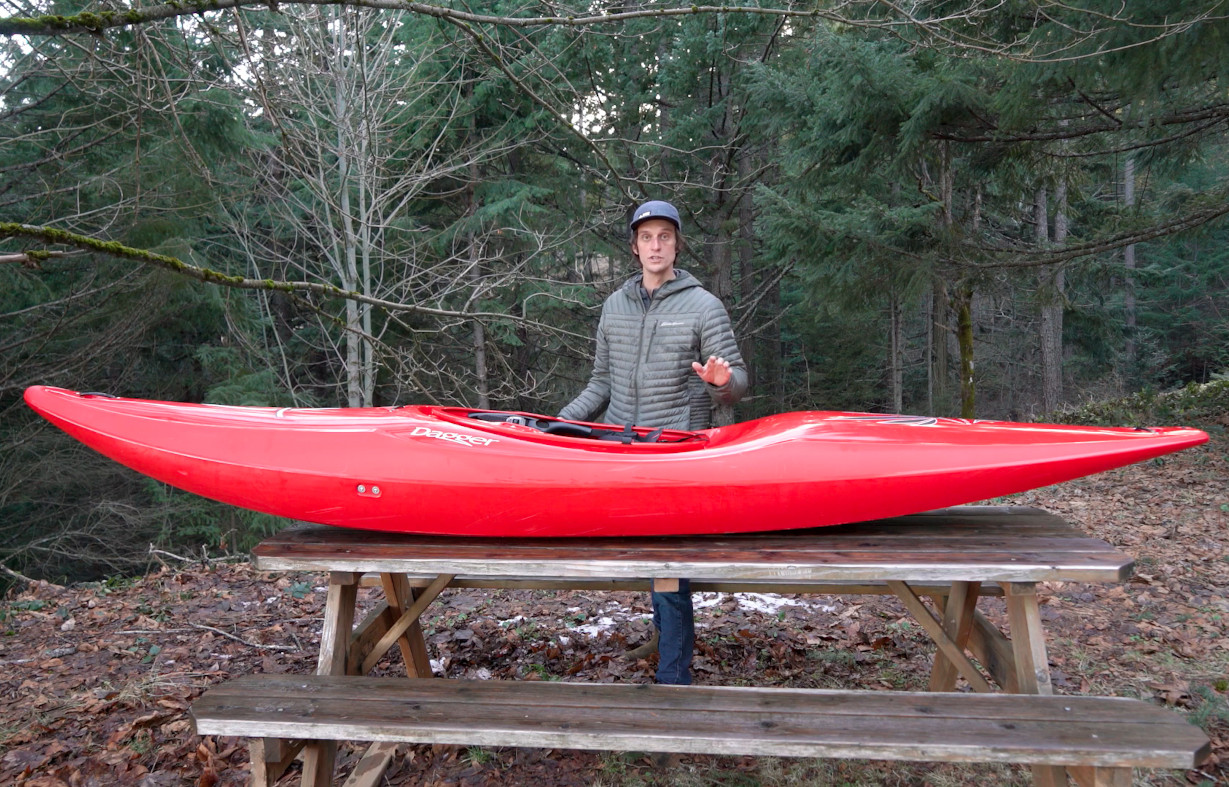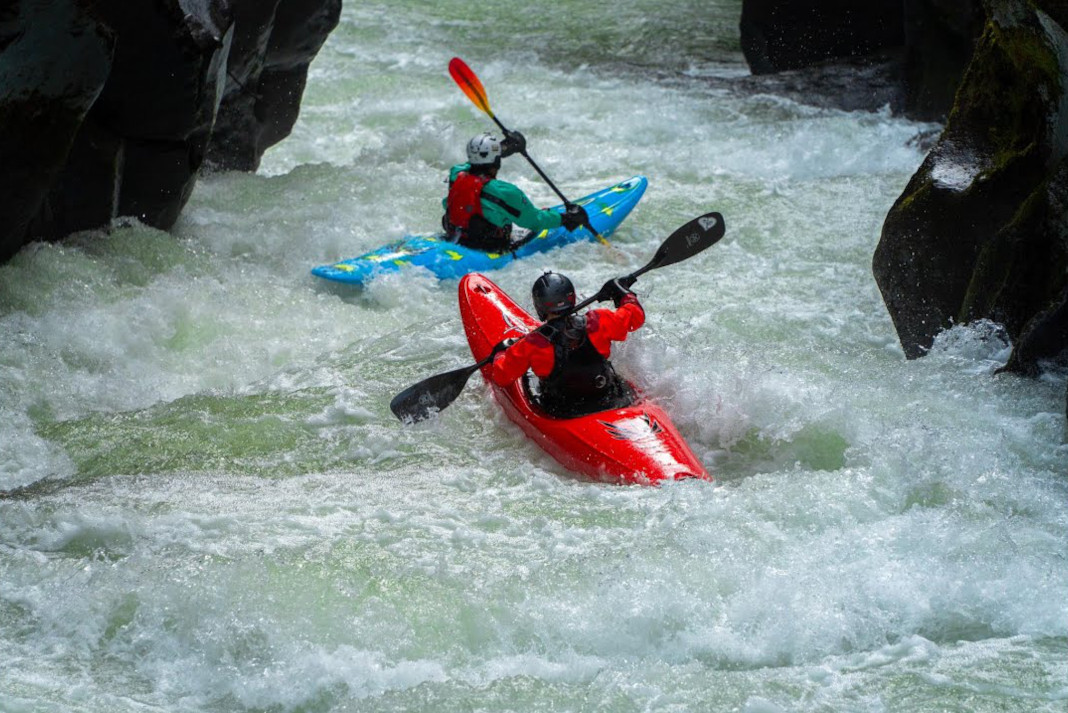Products You May Like
Fifteen years ago, Dagger Kayaks redefined the long creek boat with the release of the Green Boat. Now the brand is attempting to reinvent the category once again. After four years of prototypes, the Dagger Vanguard 12.0 has finally made its way to the paddling public for spring 2023.
Dagger’s 15-Year Evolution In Longboats
When Dagger’s Green Boat was made, it was built for one thing: winning the namesake extreme race in the Southeast U.S.
In downriver whitewater races, a kayak over nine feet is categorized as a longboat. In whitewater races with a longboat class, it’s generally accepted that to have the fastest time on the river you’ll need to be piloting from the seat of one. Choosing to do so in extreme races, namely the Green Race, provides the potential to unlock speed. But not without the hazard of the length turning up the difficulty significantly.
Up until 2006, paddlers vying to win the Green Race were likely doing so in a Prijon Tornado, an old-school creek boat nearly 12 feet long. The Tornado had a long displacement hull, some rocker, and a half-decent amount of volume. The Tornado still somewhat resembled the creek boats being paddled in the mid-2000s. But modern designs were progressing, and the Tornado was looking its age, having been created in 1995, including because of its lack of safety features.
Then Pat Keller showed up to the Green Race in 2006 with the Dagger prototype that changed the game. The Green Boat certainly drew inspiration from the Tornado. But it was the first kayak purpose-built for winning an extreme race. It drew on design knowledge from other disciplines like slalom, as well as the latest creek boats of the time. Keller won, and the Green Boat instantly became the bar for the kayak design needed to win the race.
That said, when the Green Boat was envisioned, one of the hurdles was whether anyone outside a subculture of paddlers in the South would actually buy one. Dagger took their chances, and in 2008 the Green Boat was released in full production.
Today each major whitewater brand available in the U.S. has its take on a longboat. So it’s fitting now for Dagger to lead the field in releasing the second generation of the category. As the Vanguard was being developed, the brand had a new perspective in mind for what they hoped to accomplish with the design.
“One of the things we had in the back of our mind was how can we make this boat feel like an everyday creek boat a little bit more? How do we make it less of a transition from your regular creek boat into a longboat?” shares Snowy Robertson, kayak designer at Dagger.

Developing The Dagger Vanguard 12.0
Asking this question took Robertson and the Dagger team on a journey to develop the Vanguard that began in 2019. The first prototype of the Vanguard was a 12-foot, six-inch speed machine—nine inches longer than the Green Boat. Robertson says the boat was fast on flatwater but cumbersome to drive in technical whitewater. So they changed course, pulling the length back to 12 feet, and looked toward current creek boats, including the Phantom and Code, and the characteristics that make them feel more effortless than ever in whitewater.
“We wanted to remove that percentage of extra effort,” says Robertson. “Nine-foot creek boats nowadays are highly maneuverable. We wanted to offer that in the longer package. We looked at getting more planing surface through the center section and more of a defined rail. You are also sitting up on the surface a bit more, rather than being down in the water as the Green Boat was.
“We’re definitely using less of that waterline, and so it’s slower through the flatwater,” Robertson explains. “But we found that you can be much more precise with where you place the boat, and the bow is much easier to keep on the surface. We honestly found that we were using less effort and being less fatigued than you would’ve been with our other longer boats, which were seemingly faster.”
A Boat Built Beyond Race Day
Following Robertson and Dagger’s four-year R&D effort is the finalized Vanguard 12.0. In Dagger’s unveiling video, Team Manager Todd Wells walks through the features of the design Robertson discussed. He also notes the natural feeling cockpit, that the boat is capable of spinning from the center, and the tapered stern with reduced volume that frees it from the water, while also making it capable of some slicing—which other recent creek boats have moved toward.
What stands out most watching footage of athletes in the Vanguard is exactly what Robertson refers to: the ease of the Vanguard as a longboat. On a run like the Little White Salmon, the paddlers don’t look like they are laboriously driving a longboat. Instead, it seems like just another day on a classic section of steep, pushy class IV-V whitewater. In fact, last year Todd Wells won the Little White Salmon Race in the 12-foot prototype of the Vanguard, an event not known to harbor longboats on the roster. But Robertson says with the ease the Vanguard paddles compared to previous longboats, expect to see more on the starting line.
“This year will be even more telling of people stepping up and paddling longer boats on there because the style of the boat is just more comfortable and familiar in that whitewater,” says Robertson. “It’s a more manageable and approachable boat and will open up harder paddling scenarios in a 12-foot boat than we’ve ever thought possible.”
Dagger Vanguard 12.0 Specifications
Length: 12′ / 366 CM
Width: 25″ / 63.5 CM
Volume: 104 GAL / 393 L
Boat Weight: 60.5 LBS. / 27 KG
Paddler Weight: 120 – 280 LBS. / 54 – 127 KG
Find more info on the new Dagger Vanguard.
